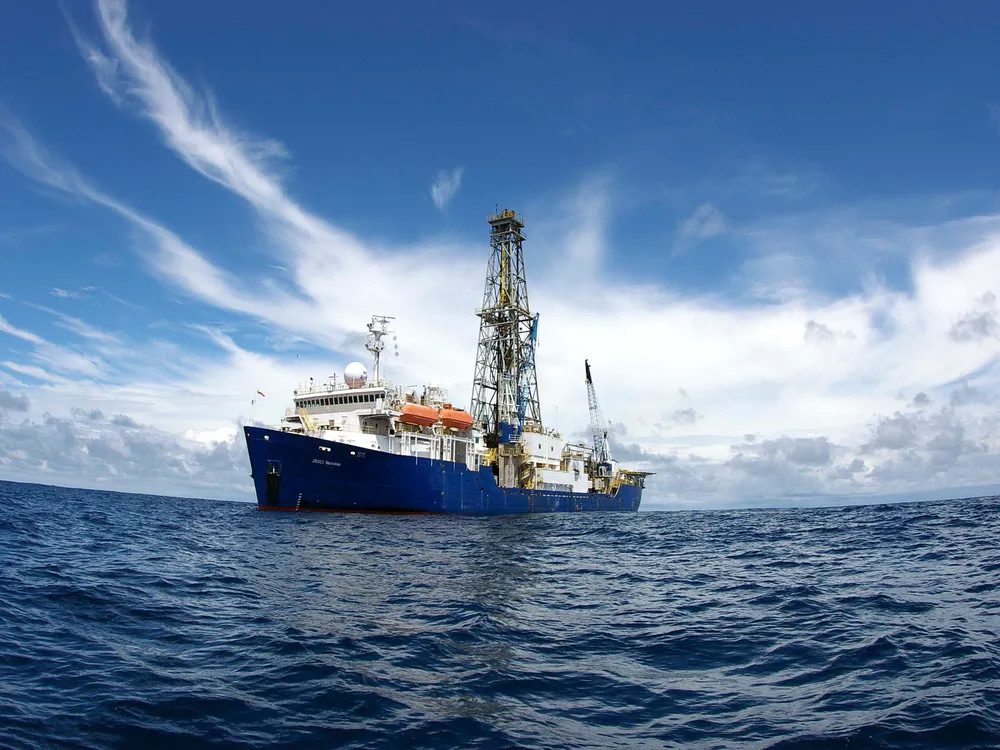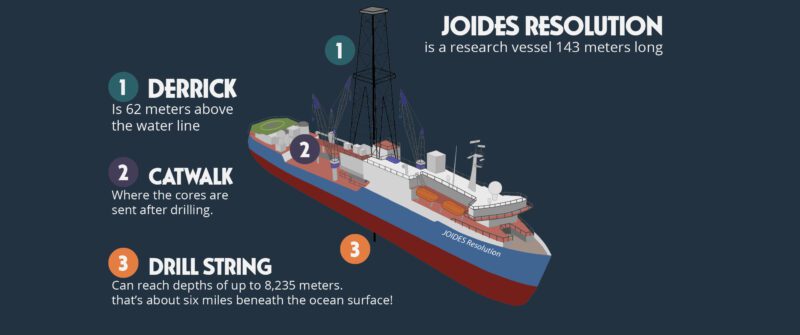BOEM Announces Second Gulf Lease Sale Under Energy Expansion Program
The Bureau of Ocean Energy Management has announced a Proposed Notice of Sale for its second offshore oil and gas lease sale under the One Big Beautiful Bill Act, scheduled...

by Suzanne OConnell (Wesleyan University) My favorite place in the world isn’t a fixed location. It’s the JOIDES Resolution, an internationally funded research drillship that has spent its service life constantly on the move, from deep in the Antarctic to high in the Arctic.
Since 1985, scientific expeditions on this one-of-a-kind oceangoing laboratory have drilled 230 miles (370 kilometers) of sediment and rock cores – long cylindrical samples that provide a unique view of the ocean floor. The cores come from a thousand different locations, enabling scientists from many universities around the world to explore changes within the Earth.
They also provide a window into our planet’s history. The ocean floor preserves a geological library that documents millions of years of climate change and evolution.
Sadly, the JOIDES Resolution, also known as the JR, may have sailed for the last time. On Aug. 2, 2024, it docked in Amsterdam, with no clear path to raise the US$72 million per year that’s needed to operate the vessel. Most of this funding comes from the U.S. National Science Foundation, which announced in 2023 that it would not fund the JR beyond 2024 because contributions from international partners were not keeping up with rising costs. Crews have started removing scientific equipment from the ship.
The National Science Foundation says it will support ongoing research using existing core samples and work with scientists to plan the future of scientific ocean drilling. But for me and many other scientists, the cost of operating the JR pales compared with the damage caused by a single large earthquake – such as Japan’s 2011 Tohuku-Oki quake, estimated at $220 billion – or the trillions of dollars in damages resulting from climate change. Ocean core research helps scientists understand events like these so that societies can plan for the future. Decades of ocean drilling have helped scientists understand the history and behavior of Antarctica’s ice sheets. Ice shelf loss is a major driver of global sea level rise.
No other vessel has the JR’s capabilities. The ship is 469 feet (143 meters) long – 50% longer than a football field. It has more than 5 miles (8 kilometers) of drill pipe that connects the ship to the seafloor and the layers beneath it, allowing it to raise core samples from the subsea to the ship.
The JR’s dynamic positioning system enables it to stay fixed exactly in one spot for days or weeks at a time. Just two other ships in the world have this capability: the Chikyu, a larger vessel operated by Japan in Japanese waters, and a new Chinese drilling ship called the Mengxiang.

I’ve spent eight two-month expeditions on the JOIDES Resolution, primarily at high latitudes near the poles exploring past climates. Each trip was staffed with about 60 scientists and technicians and 65 crew members. Once the ship left port, operations ran 24 hours per day, every day. We all worked 12-hour shifts.
These voyages could be grueling. Usually, though, the excitement of new and often unexpected discoveries, and camaraderie with fellow participants, made time speed by.
As early as the 1960s, geologists began to understand that Earth’s continents and oceans were not static. Rather, they are part of moving plates within the Earth’s crust and upper mantle. Movement of the plates, especially where they collide with one another, creates earthquakes and volcanoes.
Marine sediment cores can penetrate a mile or more into the Earth’s crust. They provide the only opportunity to investigate continuous changes in tectonic plate interactions, study climate and marine evolution, and explore the limits of terrestrial life. Here are four areas where the details of these processes have begun to emerge:
Tectonic plate creation
Oceanic crust is fundamentally different from the crust that lies under the continents. When I first learned about it in the 1970s, the model for its formation and structure was simple:
– Lava rose from magma chambers beneath chains of seafloor volcanoes, known as ocean ridges.
– It poured out onto the seafloor, creating a dark, often glassy, volcanic rock called basalt.
– Within the deeper, slowly cooling magma chamber, crystalline minerals formed, creating rocks with a texture similar to granite.
– Over millions of years, this new crust moved away from the ridges, becoming cooler and denser.
But cores retrieved by the JOIDES Resolution, along with studies using underwater robots called submersibles, revealed that this view was inaccurate. For example, they showed that seawater circulates through the crust, changing its composition and the chemistry of the seawater itself.
Core studies also showed that Earth’s mantle – a foundation thought to lie deep below the surface – moves on giant, previously unknown fault zones and extends upward to the surface of the ocean crust. The mantle may provide clues to the origins of life.
These insights changed scientists’ basic understanding of how our planet is structured.
Climate records in ocean crust
My particular interest is in sediments that accumulate on the ocean crust. These deposits contain tiny microfossils of plankton, including organisms such as diatoms and coccolithophores that live on or near the ocean’s surface. As they photosynthesize, they absorb carbon dioxide from the atmosphere and produce half of all the oxygen that we breathe.
Types of plankton vary with the temperature and chemistry of seawater. When they die and fall to the sea floor, they preserve an excellent record of past climates. Scientists use them to understand how Earth’s climate has warmed and cooled in the past.
Another information source is sediments that fall out of melting icebergs. Glaciers pick up rocks as they flow over land. When they reach the sea, parts of them break off to become icebergs. The ice melts when it is exposed to warmer ocean water, and the rocks fall to the seafloor. These rock deposits in sediments are a record of past transitions between warm and cold climates.
Plate destruction and recycling
Most of the Pacific Ocean and some regions of the Atlantic Ocean lie over zones called convergent margins, where tectonic plates crunch against each other. This process forces some ocean crust and sediment down into the Earth, where it melts and eventually is recycled into new crust, often as volcanoes.
Giant faults along these margins can create enormous earthquakes, such as the 2011 Tohoku-Oki earthquake off the eastern coast of Japan. Cores taken near such faults help scientists understand the forces that cause these events. They also create openings where instruments can be inserted to monitor for future earthquakes.
Cores recovered from convergent margin areas have also begun to reveal how volcanoes are created and how they modulate long-term climate change by producing carbon dioxide emissions.
The limits of terrestrial life
In the late 1970s, exotic new forms of terrestrial life were discovered in the Pacific Ocean at zones where ocean crust formed. At plate boundaries, cold seawater percolated down through cracks in the crust. There, it was reheated by hot magma and jetted upward through openings that scientists named hydrothermal vents.
The hot water contained minerals, which cooled when they touched cold seawater and hardened into chimneylike structures around the vents. Hundreds of life forms, including microbes, mussels and tube worms, colonized these structures, thriving near zones of intense pressure and temperatures as hot as 248 degrees Fahrenheit (120 Celsius).
JR coring has subsequently revealed other life forms that survive deep in the subfloor of the ocean, in conditions of extreme oxygen and energy deprivation. Scientists know almost nothing about the diversity of these organisms, or the metabolic strategies they use to survive in their challenging environment. Understanding how they thrive could inform missions to other planets, such as Saturn’s moon Enceladus and Jupiter’s moon Europa, that have subsurface oceans that might support life.
The National Science Foundation has created a committee to consider what capabilities a new drilling ship should have, and Congress may provide funding for additional JR expeditions in 2025. Given how much scientists still don’t know about Earth’s history, and the challenges humanity faces in adapting to climate change, I and my colleagues hope the JOIDES Resolution can still sail again, and that a new ship eventually will take up its mission.
Suzanne OConnell, Harold T. Stearns Professor of Earth Science, Wesleyan University
This article is republished from The Conversation under a Creative Commons license. Read the original article.

Sign up for gCaptain’s newsletter and never miss an update

Subscribe to gCaptain Daily and stay informed with the latest global maritime and offshore news
Essential news coupled with the finest maritime content sourced from across the globe.
Sign Up